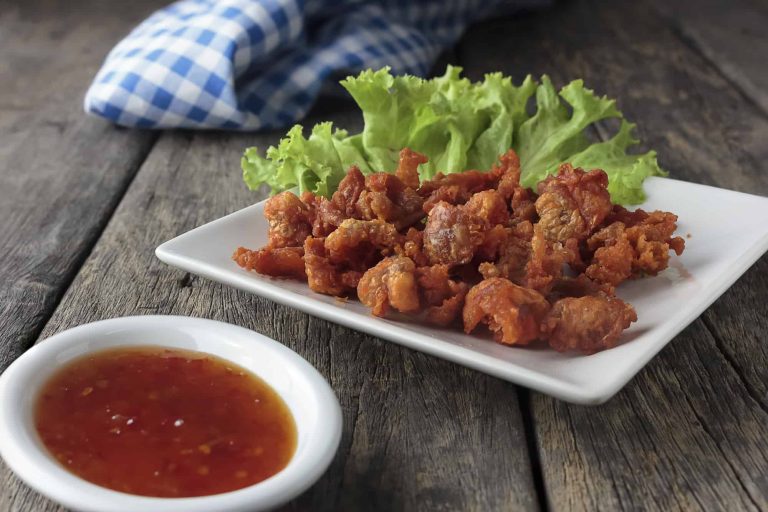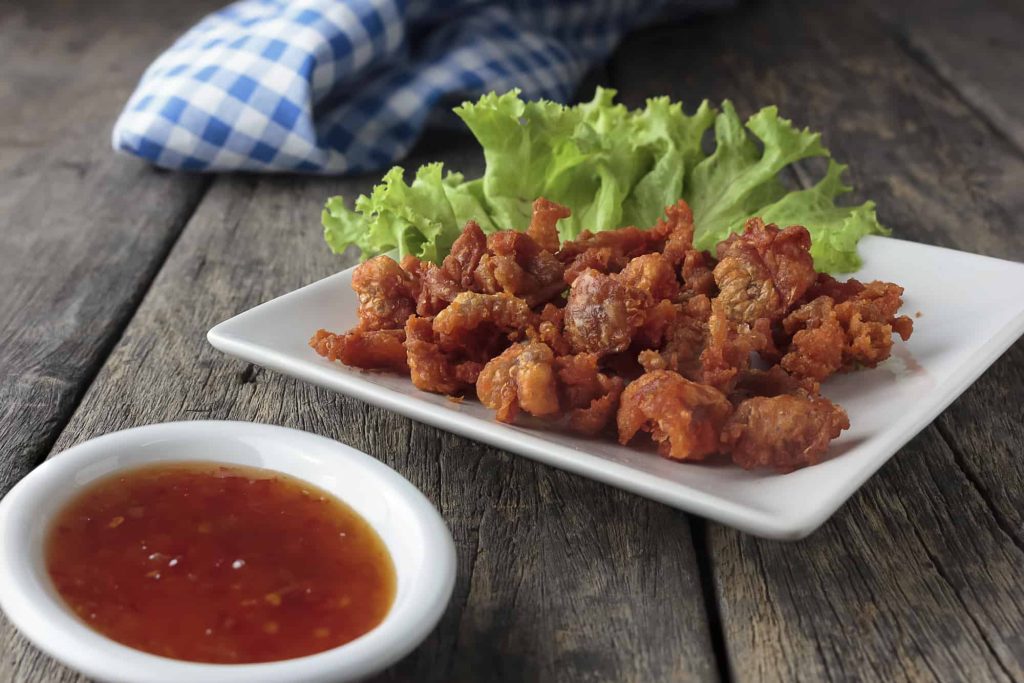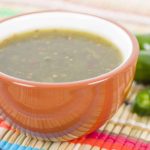If you haven’t tried chicken skin yet, you’re missing out! How can you put it to use?
Chicken skin is an underrated and versatile ingredient. You can use it to make chips (a classic), chicken skin wraps, chicken stock, sausage, chicken fat, soup, and more! However, as delicious as it is, we recommend not eating it regularly.
So, if you want to know what else and how you can cook chicken skin, read on!
What Can You Cook With Chicken Skin?
Chicken skin is known to be a threat to heart and cardiovascular health due to its cholesterol content, which is even higher than chicken fat (source: Lipids in Health and Disease).
However, it has been reported that it also contains unsaturated fatty acids that are good for you, so it’s not bad for an occasional treat!
Chicken skin can be bought at the local butcher, farmer’s market, specialty shops, and in the frozen section of the grocery store.
You can find raw chicken skin at the butcher’s or farmer’s market, or frozen at the supermarket. It may be unseasoned or seasoned. Ready-to-eat fried or roasted chicken skin is also commonly available.
Read more of our article that will guide you through the best places and online stores to buy chicken skin and satisfy your cravings.
Here are some ways to put the skin to use in the kitchen, whether it’s raw or cooked:
Raw Chicken Skin
1. Chips or Crisps (Roasted or Fried)
Also called cracklings or chicharrones, this is probably the most popular and widely prepared chicken skin snack.
To prepare, first, dry the raw chicken skin that you removed from the chicken breasts or thighs or the pack you bought. Any moisture present will not make the skin crispy.
Season with your favorite seasoning, herbs, spices, and salt, but don’t overdo it. The skin will shrivel, which will intensify the flavor.
If you want to bake your chicken skin rather than fry it, make sure you’ve pre-heated the oven to 400 °F (204 °C). Bake for 15–20 minutes or until golden brown.
If you prefer frying, you can boil the skin beforehand. You can also season it before refrigerating to add flavor and remove moisture at the same time.
Heat oil at 350 °F (175 °C) in a large pot. Carefully fry chicken skin batch by batch for 3–4 minutes or until crispy. If you haven’t seasoned it already, sprinkle it with salt and spices. Then, place on a paper towel to dry.
2. Gribenes and Schmaltz
This is a traditional Jewish dish. Chicken skin is rendered to produce oil in a cast iron skillet or non-stick pan on low to medium heat.
Fat rendering is when you take a source of fat (chicken skin in this case) that’s solid, heat it, and wait for the fat or oil to come out of it. This is also done to remove excess water.
Once the fat is rendered, onion is added and the chicken skin is cooked for 15–20 minutes in medium heat and an unopened skillet.
The whole dish can be called gribenes, while the fat rendered is called schmaltz.
3. Chicken Skin Wraps
Chicken skin can be a good substitute for bacon in dishes like bacon-wrapped green beans or asparagus. However, since it is small, it can be hard to wrap bigger foods like tenderloins. It works great for finger foods.
You can use chicken skin to wrap baked water chestnuts, sausage, asparagus, or grilled mushrooms.
When it’s not thoroughly cooked, chicken skin can feel gooey and almost rubbery. We recommend cooking it until it is crispy for safety and flavor.
4. Salads
Love to eat your greens but want something deliciously crispy? Add a couple of fried or roasted chicken skins to them!
5. Chicken Stock
Chicken skin can also be added to chicken bones to make chicken stock or chicken broth. You can also add onions, carrots, celery, and other vegetables to enhance the flavor.
The inclusion of chicken skin in soup or broth has been a topic of debate among culinary enthusiasts. To help you make an informed decision, read the article that examines the result of using chicken skin in broth or soup here.
By understanding its potential benefits and drawbacks, you’ll gain valuable insights into whether using it in your soup or broth is the right choice for you.
6. Chicken Sausage
Some commercial chicken sausage brands actually add chicken skin to the sausage to add flavor and moisture. So if you make your own chicken sausage at home, you might want to consider adding chicken skin.
7. Chicken Fat
If you want to collect the fat or oil from chicken skin, you can do so by rendering it in a pan on low to medium heat. Carefully collect the fat after and use it to saute vegetables or meat.
Leftover Chicken Skin
8. Re-fried Chicken Skin
Rendered chicken skin can be re-fried in hot vegetable oil to give it a crispy texture. Eat it on its own or use it for other delicious dishes you like, such as salads or wraps.
9. Soup
Have leftover chicken skin chips? You can still repurpose them as a topping for soup! Season and roast it before adding it to soups for a burst of flavor.
10. Crispy Chicken Skin Bits
You can also use your leftover chicken skin by re-frying it and grinding it into small bits that you can toss in salads, add to dips, or sprinkle on baked potatoes or scrambled eggs. Use them the same way you would use bacon bits!
Eaten in moderation, chicken skin is a delicious and versatile treat. We Give these ideas a try the next time you have leftovers to use!







Comments are closed.